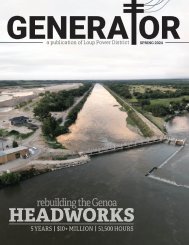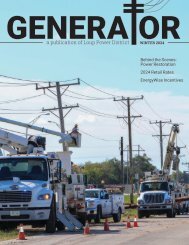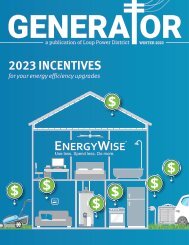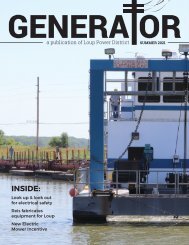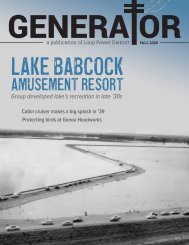Generator — Summer 2023
Learn about the Columbus Public Power Building and a building restoration project in Creston.
Learn about the Columbus Public Power Building and a building restoration project in Creston.
Create successful ePaper yourself
Turn your PDF publications into a flip-book with our unique Google optimized e-Paper software.
GENERA OR<br />
a publication of Loup Power District SUMMER <strong>2023</strong><br />
Columbus’ Public Power Building<br />
Once a testament to the city’s power and progress,<br />
current City Hall to be demolished this year<br />
Citizens State Bank<br />
Creston entrepreneur restoring historic building
BOARD OF DIRECTORS<br />
Steve Heesacker<br />
Chairman<br />
Bob Cerv<br />
First Vice Chairman<br />
Jim Donoghue<br />
Second Vice Chairman<br />
Mike Fleming<br />
Secretary<br />
Dick Tooley<br />
Treasurer<br />
Rich Aerni<br />
Alan Drozd<br />
Chris Langemeier<br />
Larry Zach<br />
EXECUTIVE STAFF<br />
Neal Suess<br />
President/CEO<br />
Walt Williams<br />
Vice President,<br />
Accounting & Finance/CFO<br />
Todd Duren<br />
Vice President,<br />
Corporate Services<br />
Korey Hobza<br />
Vice President, Engineering<br />
Dan Hellbusch<br />
Vice President, Operations<br />
The Loup <strong>Generator</strong> is<br />
published quarterly<br />
as a service for Loup<br />
employees, families,<br />
friends, and associates.<br />
For feedback, story ideas<br />
and submissions, contact:<br />
Stacy Wemhoff<br />
Communications Coordinator<br />
402-562-5711<br />
swemhoff@loup.com<br />
RETIREE PROFILE: BOB ANDERSON<br />
Bob Anderson had a feeling<br />
he’d end up working at Loup<br />
Power District.<br />
His grandpa, Pete, was<br />
a dredge operator at the<br />
Genoa Headworks. So was his<br />
dad, Gilbert Anderson. And<br />
eventually he became one too.<br />
“It’s what I always wanted to<br />
do,” he said.<br />
Anderson was a selfemployed<br />
drywall installer in<br />
1997 when he saw a job open up<br />
at Loup and decided to apply. He<br />
knew his dad and grandpa enjoyed the work.<br />
His uncle, Bob Ramaekers, also worked for<br />
Loup as Genoa Local Superintendent.<br />
He was hired as Maintenance Man at<br />
the Headworks in 1997 and was promoted<br />
to Equipment Operator in 2002. In 2012,<br />
he achieved his goal of becoming Dredge<br />
Operator and continued in that role until his<br />
retirement last year.<br />
In that role, Anderson was responsible for<br />
dredging sand from the Loup canal settling<br />
basin at the Headworks just southwest<br />
of Genoa. Dredging takes place in the<br />
spring and fall. In the off season, he helped<br />
maintain the dredge.<br />
“When you’re not dredging, you’re fixing<br />
something,” Anderson said. “Sand destroys<br />
everything.”<br />
He also took care of a variety of other<br />
tasks, such as steaming the intake gates in<br />
the icy winters or checking the canal during<br />
his night shifts.<br />
Some people hate working in temperature<br />
extremes. But Anderson wasn’t<br />
one of them.<br />
“I love the outdoors,” he said.<br />
And he loved working at Loup<br />
<strong>—</strong> until 2019.<br />
“I enjoyed it right up until the<br />
flood,” Anderson said. “It was<br />
heartbreaking.”<br />
A storm in March that<br />
year dumped rain on top of<br />
melting ice, causing ice jams<br />
and flooding that breached the<br />
canal and destroyed areas of the<br />
Headworks.<br />
“All the work we did and in 24 hours it<br />
was gone and we had to start all over.”<br />
The result was months of working<br />
overtime every week. In addition, Anderson<br />
said the shift work can be tiring after many<br />
years. And that’s how he knew it was time to<br />
retire.<br />
He said retirement started off pretty good<br />
last fall.<br />
“Then winter hit and it was awfully<br />
boring,” he joked.<br />
Still, he has plenty of projects to keep<br />
him busy in retirement <strong>—</strong> yard work and<br />
property and vehicle maintenance.<br />
He does miss the Headworks, the<br />
coworkers, and the dredge. He drives out for<br />
a visit every once in a while and takes a look<br />
at the dredge.<br />
It was his home away from home for 25<br />
years and it’s been hard to leave it behind.<br />
But then he throws a fishing line in<br />
the canal, sits back to relax, and realizes<br />
retirement isn’t so bad after all.<br />
2 | GENERATOR
PRESIDENT’S MESSAGE<br />
2019 storm damage totals $9.8M<br />
FEMA reimbursement stands at $4.5M to date<br />
It has been more than four years since the 2019<br />
mid-March storm affected the District and<br />
the operations with the hydroelectric facilities.<br />
I often get asked about where things stand<br />
regarding repairs and reimbursement for the<br />
repairs the District has made.<br />
For the most part, all of the repairs regarding<br />
the hydroelectric facilities have been completed.<br />
There is still minor work to do on the canal<br />
banks to ensure they are sloped and firmed up,<br />
but for the most part, these repairs are completed.<br />
The District is still waiting to bid out an<br />
overflow structure along the canal near the<br />
Headworks operation. This overflow structure<br />
is meant to return water from the canal to the<br />
Loup River when excess water enters the canal.<br />
This was a requirement from the Federal Energy<br />
Regulatory Commission (FERC).<br />
The District has received all approvals on the<br />
design concept from FERC and is just waiting<br />
on approval from the Federal Emergency<br />
Management Agency (FEMA) to bid the project<br />
out and start the construction.<br />
Regarding cost and reimbursement, to date the<br />
District has spent approximately $9.8 million<br />
on repairs from the 2019 storm. The District<br />
has been reimbursed slightly more than $4.5<br />
million from FEMA and insurance; however,<br />
we expect to eventually be reimbursed for almost<br />
all expenses associated with repairs from<br />
this storm.<br />
Sometimes it is frustrating at the amount of<br />
time it takes to get reimbursed for project<br />
costs from FEMA. The District has had to front<br />
this money, all the while waiting for the reimbursement.<br />
This has affected the District’s<br />
cash flow, but luckily the District’s financial<br />
position was strong before the 2019 storm, and<br />
we have been able to weather the slow nature<br />
of reimbursement by using cash reserves and<br />
not issuing any new debt, all the while keeping<br />
retail rates stable and cost effective.<br />
Once all of the funds are reimbursed from<br />
FEMA, the District’s cash position will be<br />
much better and the financial flexibility will be<br />
back to pre-2019 conditions.<br />
Coming back from the 2019 mid-March storm<br />
has taken a lot of resilience from all District<br />
employees, and this has been a challenge.<br />
Having to deal with facilities that are damaged<br />
and making repairs while trying to keep the<br />
facilities in operation takes a great deal of effort<br />
and concentration. All District employees<br />
should be proud of their performance during<br />
this difficult period.<br />
Storms like the one in 2019 are never fun to<br />
deal with, but they are a way of life in our industry.<br />
Wind and ice storms can damage poles<br />
and lines, and District employees respond to<br />
these quickly and efficiently. It is one of the<br />
many reasons I am proud to work at Loup<br />
Power District.<br />
NEAL SUESS<br />
President/CEO<br />
SUMMER <strong>2023</strong> | 3
the VAULTon MAIN<br />
Entrepreneur infuses new life into old building<br />
Jamie Olmer was only 21 when she bought a building in<br />
her hometown of Creston.<br />
It had tar paper covering the plaster walls and sunlight<br />
shone in through the roof. Most of the boarded-up<br />
windows were broken and others were bricked over. A part<br />
of one wall had caved in and the building had significant<br />
water damage.<br />
But all she saw was potential. “I knew I had to try to save<br />
it,” she said.<br />
PURCHASING THE BUILDING<br />
Olmer was working at Mark’s Custom Woodworking<br />
in Creston in the summer of 2011. Owner Mark Korth also<br />
owned the former Citizens State Bank across the street. He<br />
bought it in 2005 when Central Valley Ag closed.<br />
He no longer had use for the building and was thinking<br />
of tearing it down.<br />
Olmer <strong>—</strong> who was studying history in college <strong>—</strong> was<br />
saddened by the thought. She had always admired the<br />
building and wished someone would use it. Her mom, Lynn<br />
Olmer and grandparents, Nancy and the late John Scheffler,<br />
were also passionate about their town’s history and knew<br />
the building was worth saving.<br />
Olmer asked Korth for the keys to get a look at the inside<br />
of the building. It was definitely in rough shape, but she<br />
decided to ask if he would be interested in selling it.<br />
“After all the years of hoping someone would use the<br />
building, standing inside it that day, I realized that I could<br />
do something about that,” she said.<br />
A year later, the keys and building were hers at a cost of<br />
$5,000. But it would have to wait a while for those muchneeded<br />
repairs. Olmer had a few more years of college.<br />
Then she traveled with the national service program<br />
AmeriCorps for three years. After that was graduate school<br />
and a then full-time job in 2020.<br />
During that time, Olmer had been researching and<br />
getting estimates for the repairs, so she knew that it was<br />
going to be an expensive project. Now that she had a steady<br />
income, it was time to get back to the building eight years<br />
after buying it.<br />
4 | GENERATOR
Top left: The state of the former<br />
Citizens State Bank before restoration<br />
work.<br />
Top: The Vault on Main owner Jamie<br />
Olmer talking about her project at a<br />
Community Builders meeting in March.<br />
Left: One of the first projects Olmer<br />
tackled was replacing the roof of the<br />
building.<br />
CITIZENS STATE BANK HISTORY<br />
Citizens State Bank was established<br />
in 1898. It grew rapidly and broke<br />
ground for a new building in 1920,<br />
holding an open house in 1921.<br />
The new bank was “one of the<br />
most modern and up-to-date bank<br />
buildings in this part of Nebraska,”<br />
according to the Creston Statesman.<br />
It featured mahogany and marble<br />
throughout its interior.<br />
The bank also featured a terra<br />
cotta exterior. By the 1920s, terra<br />
cotta was becoming more and more<br />
popular with architects because<br />
it was fireproof, economical, and<br />
lightweight. It was also easier and<br />
cheaper than carving stone.<br />
But the bank’s opulence and<br />
customers could not save it from the<br />
Great Depression and it closed in 1931.<br />
The bank continued to own the<br />
building until 1940 when it was sold<br />
by public auction to the Village of<br />
Creston for $102.50. It had a variety of<br />
uses until 1946 when it was purchased<br />
by a local family and turned into a<br />
meat locker. Farmers Cooperative Oil<br />
Company bought the building in 1964<br />
and used it for feed storage. Korth<br />
bought it in 2005 along with some<br />
adjoining buildings. It was unused and<br />
empty.<br />
NATIONAL REGISTER<br />
Right after buying the building,<br />
Olmer began steps to get it listed<br />
on the National Register of Historic<br />
Places.<br />
She visited the Nebraska State<br />
Historical Society and the State<br />
Historic Preservation Office (SHPO).<br />
Olmer explained that she was trying<br />
to dig up information on a building in<br />
a really small town. A SHPO employee<br />
there said they had an inventory of<br />
historically significant buildings<br />
throughout the state and they may<br />
have information.<br />
“Not knowing how rare and unique<br />
of a building this really was, I was<br />
sure they would not have a file on it,”<br />
Olmer said. “I stressed that this was a<br />
building in a very small town.”<br />
But as soon as she said “Creston”<br />
she learned about the significance of<br />
her small-town building.<br />
“The wedding cake?” the employee<br />
exclaimed and got the attention of<br />
everyone in the office who wanted to<br />
know her plans for the building.<br />
Olmer learned that the bank<br />
was designed by famous architect<br />
Frederick W. Clarke of Omaha.<br />
“There are plenty of buildings clad<br />
in terra cotta, but this one has two full<br />
sides, an enormous amount of detail,<br />
and color,” Olmer said.<br />
Most other terra cotta buildings<br />
in the state, such as Union Station<br />
(now Durham Museum) in Omaha are<br />
monotone. The Creston bank is mostly<br />
white, but with striking color accents.<br />
The façade features colorful lions’<br />
heads and floral swags. A large arch<br />
and columns flank the front door.<br />
“The details for the lions and the eagle<br />
are just amazing,” Olmer said.<br />
RESTORATION<br />
In 2020, the Covid-19 pandemic<br />
gave Olmer the extra time to begin<br />
restoring the building.<br />
The obvious first step was a new<br />
roof which involved replacing the<br />
north wall of the building. Then came<br />
the fun stuff <strong>—</strong> tearing out 18 inches<br />
of cement and filler on top of the<br />
original floor that was put in for the<br />
meat locker.<br />
SUMMER <strong>2023</strong> | 5
The Vault on Main has two full sides of terra cotta with color on its exterior <strong>—</strong> a rarity in the state.<br />
“After we took it all out, we did the<br />
math to find it was 72,500 pounds of<br />
concrete that we removed,” she said.<br />
Then she put in custom windows<br />
and a new front entrance.<br />
The work is still getting done in<br />
spurts, with Olmer driving from<br />
Omaha on the weekends. She has help<br />
from family and friends.<br />
“It’s getting to be a long list, but<br />
my mom is almost always there<br />
working on it with me,” Olmer said.<br />
“My uncle, Jim Scheffler, and cousins<br />
Anthony and Austin Bruhn, and<br />
boyfriend, Daniel Primi, have put in a<br />
lot of hours as well.”<br />
After the major repairs, she began<br />
to work on designing the interior<br />
spaces. She sent a survey in Creston<br />
residents’ water bills asking what<br />
use they envisioned for the building.<br />
She also posed the question on social<br />
media. The overwhelming response<br />
was a small event venue.<br />
Others mentioned the need for an<br />
Airbnb rental, a library, and a gym.<br />
Olmer plans to merge the ideas<br />
<strong>—</strong> creating an event venue on the<br />
main floor with an Airbnb on the<br />
mezzanine. She also wants to include<br />
a free library with bookshelves lining<br />
the walls. Once that is done, she would<br />
like to create a gym in the basement.<br />
But all this comes at a significant<br />
cost. “At this point I have $193,000 in<br />
this building and it still is not usable,”<br />
she said.<br />
Above: Olmer custom designs tiles to<br />
raise money for the building’s restoration.<br />
The tiles will be displayed along<br />
the west wall.<br />
Of that, the majority is a personal<br />
loan. The rest she has funded herself<br />
or paid for through donations.<br />
Olmer was surprised at the number<br />
of people who wanted to donate to<br />
her private project. They even asked if<br />
she’d do a fundraiser.<br />
“I told them, ‘If you want to donate<br />
to a privately owned building, then<br />
your name is going to be in there,’”<br />
Olmer said.<br />
From that, she got the idea to sell<br />
tiles. For donations of $100 or more,<br />
Olmer custom designs and engraves<br />
3-inch by 6-inch ceramic tiles. She<br />
has made more than 100 tiles so far<br />
and they will be installed on the west<br />
wall.<br />
“Funding is obviously one of the<br />
biggest barriers in a project like<br />
this,” she said. And that’s why the<br />
completion date is uncertain.<br />
But it has been worth it and Olmer<br />
is looking forward to the day when an<br />
old building will finally have new life.<br />
“People have often been surprised<br />
by my willingness and determination<br />
to take on such a daunting project,”<br />
Olmer said. “I joke all the time that<br />
someone does have to be some sort<br />
of crazy to try to do something like<br />
this.”<br />
But in all seriousness, she said<br />
her work is really a reflection<br />
and continuation of her family’s<br />
dedication to the community of<br />
Creston.<br />
Her grandparents, John and<br />
Nancy Scheffler, were involved in<br />
starting the Rescue Unit, served<br />
on various boards and community<br />
groups, started the annual 4th of July<br />
fireworks display, and volunteered<br />
countless hours for community<br />
celebrations and events.<br />
“I grew up volunteering right<br />
alongside them along with many<br />
other family members,” Olmer said.<br />
“This is just another way the Scheffler<br />
family is giving back to Creston. I<br />
am so excited for the day when the<br />
community can use this beautiful<br />
building again.”<br />
LEARN MORE:<br />
Visit “The Vault on Main –<br />
Creston, NE” on Facebook to<br />
follow Olmer’s progress on<br />
the building.<br />
6 | GENERATOR
The rise and fall of Citizens State Bank<br />
The Creston Statesman<br />
Friday, February 4, 1921<br />
CRESTON’S NEW<br />
MODERN BANK BUILDING<br />
The bank is a firm believer in<br />
reciprocity and felt that since they had<br />
prospered it was only right that they<br />
should do their part in the up-building<br />
of the community by erecting a home<br />
that would be a credit to the town and<br />
a real convenience to their patrons<br />
and to the public generally.<br />
With this thought in view, they have<br />
erected one of the Most Modern<br />
and Up-to-date Bank Buildings<br />
in this part of Nebraska. It is of<br />
permanent construction and fire<br />
proof throughout, and faced with<br />
white Terra Cotta of a very artistic<br />
design. The building is 26x80 feet.<br />
The interior finish and fixtures are of<br />
the finest quality of Mohagany and<br />
Marble, with Marble floor in the lobby.<br />
The whole building is arranged with<br />
an idea to convenience, giving ample<br />
room for the clerical force of the bank<br />
and general public.<br />
Some of the special features of this<br />
bank are as follows: A community<br />
room at the back of the building<br />
especially designed and arranged<br />
for the use of the public as a meeting<br />
place with access from an outside<br />
entrance, a ladies rest room at the<br />
right as you enter the building. They<br />
welcome all ladies of Creston and<br />
vicinity to enjoy its comforts. The<br />
Bank is equipped with a fire proof<br />
vault which fully protects all books<br />
and records, while funds, notes,<br />
bonds, monies, etc., are carried inside<br />
one of the latest patterns of burglar<br />
proof Manganese steel safes with<br />
triple time locks . . .<br />
The bank merits the confidence of<br />
the people and that they have this<br />
confidence is abundantly testified by<br />
the fact that they have at the present<br />
time a very large volume of business.<br />
Of course all of their customers are<br />
protected not only by their honesty<br />
and ability of management, but by<br />
the Guaranty Fund of the State of<br />
Nebraska.<br />
They want the community to feel that<br />
this is their bank and to feel that its<br />
conveniences and facilities are freely<br />
at their disposal, no matter whether<br />
they happen to be a customer or not.<br />
They feel that they are too broad<br />
minded to draw any distinctions and<br />
want you all to feel perfectly free to<br />
come in, meet friends here, to make<br />
use of its facilities in any way. Of<br />
course they want all the business they<br />
can get, but they want this based on<br />
the idea of mutual service.<br />
The Creston Statesman<br />
Wednesday, June 3, 1931<br />
CITIZENS STATE BANK TAKEN<br />
OVER STATE DEPARTMENT<br />
Doors closed at the request<br />
of Fred Rabeler on Monday<br />
The Citizens State Bank was closed<br />
Monday afternoon when a sign<br />
was put on the door saying that the<br />
institution was being taken over by<br />
the state banking department. The<br />
order was signed by Virgil Lee, state<br />
bank examiner.<br />
According to a dispatch from Lincoln<br />
Fred Rabeler, the present owner of the<br />
Creston bank, was in Lincoln Monday<br />
and requested the department of<br />
trade and commerce to take over the<br />
institution.<br />
Creston people are unable to<br />
understand Mr. Rabeler’s reason<br />
for bringing this calamity to the<br />
community<strong>—</strong>a community whose<br />
fertile lands and prosperous<br />
landowners should be proof against<br />
a bank failure. Mr. Rabeler has not<br />
been at Creston since last Thursday<br />
and hence Creston people have no<br />
statement from him regarding the<br />
closing of the bank . . .<br />
The closing of the bank is a severe<br />
blow to the entire community,<br />
whether depositors in the bank or not.<br />
While most people feel that a large<br />
percentage of the money in the bank<br />
will be paid back to the depositors, yet<br />
it will be tied up for some time.<br />
A FEW LAMENTATIONS<br />
ON THE BANK FAILURE<br />
Every bank failure has its attendant<br />
lamentations and the Creston bank<br />
flareup is no exception. After working<br />
hard all year to accumulate a sum of<br />
$150 with which to go to a Scout camp<br />
for 10 days vacation, our Girl Reserves<br />
find their money tied up in a failed<br />
bank. This is a great disappointment<br />
to these young girls.<br />
The fund for the Presbyterian<br />
Bible school is tied up in the failed<br />
institution, but the faithful teachers<br />
who have offered their time for this<br />
work are going to carry on without<br />
funds.<br />
The members of the Luther League<br />
purchased a piano recently which was<br />
to be delivered this week. Since their<br />
funds are now tied up in the failed<br />
bank with no hopes of raising the<br />
money, they are obliged to cancel the<br />
order.<br />
One man that was shooting off loudly<br />
that he had lost $300 in the failure<br />
received a sarcastic reply from a<br />
bystander that if he had paid the folks<br />
in the community whom he owed, he<br />
would not have lost a cent.<br />
SUMMER <strong>2023</strong> | 7
Columbus Public Power Building<br />
coming down after more than 80 years<br />
The City of Columbus is nearing<br />
completion of a new three-story<br />
building housing the Public Library,<br />
Columbus Area Arts Council,<br />
Columbus Area Children’s Museum,<br />
café, and City Hall.<br />
When the building is complete, the<br />
current City Hall <strong>—</strong> once known as<br />
the Public Power Building <strong>—</strong> will be<br />
demolished to make way for a parking<br />
lot.<br />
The building is coming down in the<br />
same year that Loup Power District<br />
marks its 90th anniversary.<br />
What was the Public Power<br />
Building? And why is Columbus called<br />
the City of Power and Progress?<br />
The Columbus Daily Telegram from<br />
May 14, 1941, offered readers a recap<br />
of Loup’s early history and describes<br />
the new, modern Loup office building:<br />
8 | GENERATOR
“<br />
COLUMBUS MORE<br />
THAN EVER IS POWER CAPITAL<br />
WITH NEW HOME IN USE<br />
History of District From Earliest Days<br />
Makes Gripping Story<br />
By Francis Dischner<br />
Once again The Loup River Public<br />
Power district, long the source of<br />
‘putting Columbus on the national<br />
map,’ makes important history.<br />
Its new $100,000 home, being<br />
opened to the public inspection<br />
Friday, May 16, and Saturday, May<br />
17, not only entrenches Columbus<br />
as the Power Capital of Nebraska<br />
more securely, but marks another<br />
monument to the soundness of men’s<br />
dreams of long ago.<br />
MANY DATES<br />
The Loup power district annals are<br />
full of important historic dates. Its<br />
chronology has been told many times,<br />
and detailed in hundreds of news<br />
stories through the past nine years in<br />
the columns of The Columbus Daily<br />
Telegram as well as in the press of the<br />
state and nation.<br />
History often appears as dry and<br />
sleepy matter, though it is far from<br />
that actually. It is not the purpose of<br />
this sketch to tell again the story of<br />
the rise of the Loup River Public power<br />
district from firm seed planted in the<br />
mind of man to the vast and important<br />
enterprise of 1941.<br />
Rather, let’s recall a few dates that<br />
stand out perhaps most emphatically<br />
as milestones of progress in the Story<br />
of Loup River Hydro Power.<br />
SUMMER <strong>2023</strong> | 9
ATTEMPT FAILED<br />
It has been told many times that<br />
Phil R. Hockenberger, now president<br />
of the Loup district, is credited with<br />
first conceiving the idea of a federallyfinanced<br />
power project to harness the<br />
steady flow of the Loup river.<br />
That was in September 1932.<br />
Hockenberger had, of course, since<br />
childhood, heard of repeated attempts<br />
to build a Loup power canal, and as<br />
often saw them fail.<br />
HUNTED PROJECTS<br />
In that year of fitful depression,<br />
when the Reconstruction Finance<br />
corporation, a federal lending agency<br />
created to help revive business, was<br />
looking about for sound projects<br />
on which idle men could be put to<br />
work, he suggested reviving the Loup<br />
project.<br />
His idea met with instant support<br />
at a meeting in the Thurston hotel,<br />
Sept. 15, 1932. A temporary committee<br />
comprising Charles B. Fricke as<br />
president, Dr. J. E. Meyer, vice<br />
president, C. C. Sheldon, treasurer,<br />
and Harold Kramer, secretary, was set<br />
up to direct the work. A subcommittee<br />
of A. R. Miller as chairman, and R. H.<br />
Heynen, A. H. Backus, Dr. E. E. Koebbe,<br />
Ott F. Water and Pete W. Lakers<br />
was instructed to raise $10,000 for<br />
preliminary financing.<br />
OFFICERS<br />
We skip next to April 18, 1933, when<br />
Governor Charles W. Bryan placed his<br />
signature on Senate File 310, the state<br />
enabling act which permitted setting<br />
up public power districts.<br />
On May 29, 1933, State Engineer R.<br />
L. Cochran officially created the Loup<br />
River Public Power district.<br />
In the application for the creation<br />
of the district, from a meeting held<br />
May 13, 1933, this temporary list<br />
of officers was given: Charles B.<br />
Fricke, president; Dr. J. E. Meyer, vice<br />
president; C. C. Sheldon, treasurer,<br />
and Phil R. Hockenberger, August<br />
Ewert, Edd Kelly, Ed. F. Lusienski, D. A.<br />
Becher, Dr. E. E. Koebbe, A. H. Backus<br />
and A.R. Miller, other directors.<br />
Kelly is from Monroe, Lusienski<br />
then of Platte Center. The rest are<br />
Columbus men. The board of directors<br />
automatically became permanent<br />
upon creation of the District.<br />
FIRST DIGGING<br />
Congress passed the emergency<br />
public works bill June 12, 1933 and<br />
application eventually made to the<br />
Public Works administration for<br />
construction funds. PWA approval<br />
was given Nov. 15, 1933 on the Loup<br />
application for $7,300,000 on the<br />
basis of 70 percent loan and 30<br />
percent grant for construction. First<br />
$200,000 of this amount arrived June<br />
28, 1934.<br />
First actual dragline excavation of<br />
earth was made Oct. 15, 1934 on the<br />
James Donoghue farm seven miles<br />
northwest of Columbus by the Haas,<br />
Doughty, Jones company.<br />
MARCH 1937<br />
On March 1, 1937 the switch was<br />
thrown on one of the big turbines in<br />
the Monroe Power house and electric<br />
current began flowing from the<br />
harnessed water of the Loup river.<br />
On May 29, 1937, current produced<br />
at the Monroe plant was first put to<br />
commercial use in lighting the interior<br />
of the plant. Still another red letter<br />
day in electricity was Aug. 6, 1934,<br />
when current flowing from Monroe<br />
to Columbus power house marked the<br />
first transmission of Loup power.<br />
Having ample source and supply<br />
of electric power is one thing, voltage<br />
lines to transmit it to large blocks of<br />
consumers is another.<br />
<strong>—</strong> Columbus Daily Telegram<br />
May 14, 1941<br />
10 | GENERATOR
PUBLIC POWER EXPANSION<br />
In 1936, Loup created a Rural<br />
Electrification Division to provide<br />
service to an estimated 1,400 farms<br />
in Platte, Colfax, Nance, and Boone<br />
Counties. That same year, the Rural<br />
Electrification Administration (REA)<br />
announced that it would give $391,000<br />
to Loup for construction of 355 miles<br />
of electric lines to serve an estimated<br />
319 farms.<br />
Loup initially distributed the power<br />
it generated to both private and public<br />
power companies. By 1939, there were<br />
two other hydropower districts in the<br />
state <strong>—</strong> Platte Valley Public Power<br />
and Irrigation District and Central<br />
Nebraska (Tri-County) Public Power<br />
and Irrigation District.<br />
The districts were all generating<br />
power but needed to expand<br />
their markets. They had been<br />
contemplating the purchase of<br />
private power companies for some<br />
time for that purpose. Loup had<br />
debt obligations to the Public Works<br />
Administration, posing a funding<br />
problem.<br />
On Aug. 5, the same men who<br />
organized the Loup project helped<br />
create Consumers Public Power<br />
District to facilitate the purchase of<br />
those facilities. Loup River Public<br />
Power District’s President C.B. Fricke<br />
was named president of the debt-free<br />
Consumers.<br />
In October, Consumers assumed<br />
operation of the Columbus division<br />
of the Northwestern Public Service<br />
Company through a lease-purchase<br />
agreement. It purchased the company<br />
in July 1940 with $1.2 million in bonds.<br />
It was the first acquisition of a private<br />
utility by a public power district<br />
through bond issue.<br />
The hydro facilities continued to<br />
sell power to private companies. But<br />
that would soon change. By the end<br />
of 1943, Consumers Public Power<br />
District acquired all generation and<br />
distribution facilities across the state<br />
except for Nebraska Power Company<br />
in Omaha. The cost was more than<br />
$40 million paid for by revenue<br />
bonds. This change to public power<br />
caused much controversy throughout<br />
the state with some comparing it to<br />
socialism and communism.<br />
A PUBLIC POWER SYSTEM<br />
In 1940, the three hydro districts<br />
that formed Consumers <strong>—</strong> Loup,<br />
Platte Valley, and Tri-County <strong>—</strong><br />
signed an agreement to pool their<br />
generation and revenue. This<br />
would provide stability, prevent<br />
competition and allow them to finance<br />
growth. The agreement created<br />
the Nebraska Public Power System<br />
(NPPS), a wholesale marketing and<br />
transmission agency. Its threemember<br />
board consisted of the three<br />
district managers.<br />
The three unified districts also<br />
refinanced nearly $38 million in debt.<br />
The new bonds reduced both the<br />
interest and bond payments to give<br />
the districts an opportunity to pay off<br />
obligations while building revenues.<br />
Consumers leased its generating<br />
facilities to NPPS which began<br />
coordinating power generation and<br />
transmission. Rural public power<br />
districts continued to form across the<br />
state and purchased power from NPPS.<br />
(Central withdrew from NPPS in<br />
1949 to focus on irrigation.)<br />
A NEW BUILDING<br />
By 1940, Columbus was home to<br />
four public power entities <strong>—</strong> Loup<br />
River Public Power District, Loup’s<br />
Rural Electrification Division,<br />
Consumers Public Power District, and<br />
NPPS.<br />
Management and administrative<br />
offices for the four were scattered<br />
in rented facilities, mostly along<br />
13th Street in downtown Columbus.<br />
It was time to build a facility to<br />
accommodate all four. Board members<br />
of Consumers and Loup wanted a<br />
prime location at the northeast corner<br />
of 14th Street and 25th Avenue. Grace<br />
Episcopal Church and rectory was<br />
located there, but sold their property<br />
and relocated.<br />
The new “Public Power Building”<br />
opened formally to the public in May<br />
1941.<br />
In 1970, Nebraska Public Power<br />
District (NPPD) was formed following<br />
the merger of Consumers, Platte<br />
Valley Public Power and Irrigation<br />
District. and NPPS.<br />
Four years later, Loup moved into<br />
its new office at 2404 15th Street. In<br />
1976, NPPD transferred the title of<br />
the Public Power Building to the City<br />
of Columbus and moved into its new<br />
headquarters at 1414 15th Street in<br />
Columbus.<br />
SUMMER <strong>2023</strong> | 11
PAIGE WOOD<br />
Fullerton High School<br />
<strong>—</strong><br />
Plans: Animal Science<br />
at Kansas State University<br />
Daughter of Jennifer and Tom Wood,<br />
Crew Leader; Granddaughter of<br />
Dennis and Julie Jarecke and Sharon Wood<br />
BENTLEY WILLISON<br />
Columbus High School<br />
<strong>—</strong><br />
Plans: Central Community<br />
College in Columbus<br />
Son of Jody Evans and Chad Willison;<br />
Grandson of Sharon and Robert Cerv,<br />
Board of Directors<br />
KAIDEN FERRIS<br />
Twin River High School<br />
<strong>—</strong><br />
Plans: Heating & Air<br />
at Southeast Community College in Milford<br />
Son of Keith and Katie Ferris;<br />
Grandson of Teresa and Lance Ferris,<br />
Canal Lead<br />
AALIYAH LEIGH RIHA<br />
Columbus High School<br />
<strong>—</strong><br />
Plans: Business at Central Community<br />
College in Columbus<br />
Daughter of Craig and Samantha Riha;<br />
Granddaughter of Tim and Sandi Meays,<br />
Corporate Services Administrative Assistant<br />
12 | GENERATOR
ASHTON JOHNSON<br />
Twin River High School<br />
<strong>—</strong><br />
Plans: Diesel Technology<br />
at Southeast Community College<br />
Son of Andy Johnson and Sara Janovich;<br />
Grandson of Don and Ginny Johnson,<br />
Customer Service Representative<br />
FAITH ZIMMER<br />
Twin River High School<br />
<strong>—</strong><br />
Plans: Radiology at Southeast<br />
Community College<br />
Daughter of Betsy and Kenton Zimmer,<br />
Equipment Operator; Granddaughter of Ken<br />
and Joy Zimmer and Roger and Virgie Nelson<br />
ASHTON HAPP<br />
Lakeview High School<br />
<strong>—</strong><br />
Plans: Athletic Training at Central<br />
Community College and Nebraska Wesleyan<br />
Son of Denise and Troy Dreifurst,<br />
Equipment Operator; Grandson of Margaret<br />
Bejvancesky and the late Byron Bejvancesky<br />
Area students earn scholarships<br />
LINKAGES/STEM/STEAM SCHOLARSHIPS<br />
Six high school graduates were awarded Linkages/STEM/<br />
STEAM Scholarships for their work in science, technology,<br />
and engineering courses at their high schools.<br />
The Linkages/STEM/STEAM programs are recognized<br />
nationally, supporting high schools offering quality<br />
programs. The Columbus Economic Council, Loup Power<br />
District, and local businesses provide support for the<br />
program.<br />
Scholarship recipients are: Columbus High School <strong>—</strong><br />
Tristan Kamm and Yoselin Mendez; Lakeview High<br />
School <strong>—</strong>Joshua Gembica and Caleb Neemeyer; Scotus<br />
Central Catholic <strong>—</strong> Thomas Melliger and Blake Wemhoff.<br />
The following local sponsors provided important financial<br />
support to this year’s program: ADM Corn Processing,<br />
Cargill Protein, Columbus Bank and Trust Company,<br />
Columbus Community Hospital, and TORIN Products, Inc.<br />
Since its beginning in 2004, the Linkages Program has<br />
awarded 211 scholarships totaling $69,075.<br />
LOUP POWER DISTRICT SCHOLARSHIPS<br />
Loup Power District has awarded scholarships<br />
to five area students who are attending Central<br />
Community College in Columbus this fall. The<br />
goal is to encourage students to plan careers<br />
locally after college.<br />
Selection is based on academic achievement,<br />
employment and school activities, personal<br />
statement, application, and recommendations.<br />
Scholarship recipients are: Columbus High<br />
School <strong>—</strong> Madison Mulder and Aaliyah Riha;<br />
Lakeview High School <strong>—</strong> Ashton Happ; Scotus<br />
Central Catholic <strong>—</strong> Ally Wemhoff; Twin River<br />
High School <strong>—</strong> Braden Allen.<br />
Loup has presented scholarships to high<br />
school graduates in its service territories of<br />
Nance, Boone, Colfax, and Platte counties, and<br />
a portion of Madison County, for more than 50<br />
years.<br />
SUMMER <strong>2023</strong> | 13
EMPLOYEE NOTES<br />
TRAVIS SHIVELY<br />
Maintenance Technician<br />
Travis Shively joined<br />
Loup Power District<br />
as Maintenance<br />
Technician at the<br />
Genoa Headworks<br />
in April.<br />
He is responsible for<br />
maintaining District<br />
vehicles and<br />
equipment at the<br />
Headworks. He<br />
also troubleshoots<br />
the mechanical<br />
components of the District’s dredge,<br />
the Pawnee II.<br />
Shively is a graduate of St. Edward High<br />
School and has an associate degree<br />
in diesel technology from Northeast<br />
Community College.<br />
TRENT KONWINSKI<br />
Arborist Crew Leader<br />
Konwinski joined<br />
Loup in 2008 as<br />
Apprentice Line<br />
Technician at the<br />
Columbus Service<br />
Center. He was<br />
promoted to Line<br />
Technician later that<br />
year.<br />
WELCOME<br />
He was promoted<br />
to Journey Line<br />
15 YEARS<br />
Technician in 2012<br />
and was promoted<br />
to his current position of Arborist Crew<br />
Leader that same year.<br />
Konwinski is responsible for<br />
maintaining clearance of the District’s<br />
transmission and distribution facilities.<br />
He ensures proper trimming, removal,<br />
and disposal of trees, branches,<br />
and debris that could interfere with<br />
overhead electrical lines.<br />
Konwinski is a graduate of Columbus<br />
High School and earned an associate<br />
degree in utility line from Northeast<br />
Community College in Norfolk.<br />
He and his wife, Joni, have thee<br />
children: Brayden, Braxtyn, and Blayke.<br />
DOMINIC ZOUCHA<br />
Genoa Local Superintendent<br />
Dominic Zoucha<br />
joined Loup in 2003<br />
as an Apprentice<br />
Line Technician<br />
at the Columbus<br />
Service Center. He<br />
was later promoted<br />
to Line Technician.<br />
He transferred to the<br />
Fullerton Division<br />
in 2005. In 2009,<br />
he was promoted<br />
to Journey Line<br />
Technician and was<br />
promoted to Arborist Foreman later<br />
that year.<br />
In 2012, Zoucha was promoted to<br />
Genoa Local Superintendent. In this<br />
role, he is responsible for overseeing<br />
the maintenance and construction of<br />
Loup’s electric power transmission and<br />
distribution system in the Genoa and<br />
Monroe area. He also directs customer<br />
service in the area.<br />
Zoucha is a graduate of Clarks High<br />
School and earned an associate<br />
degree in utility line from Northeast<br />
Community College. He and his wife,<br />
Amber, have two children, Beau and<br />
Caylyn.<br />
KYLE KEMPER<br />
Line Technician<br />
Kyle Kemper of<br />
Genoa joined Loup<br />
Power District as a<br />
Line Technician in<br />
Fullerton in 2022.<br />
20 YEARS<br />
He is member of<br />
the crew that is<br />
responsible for the<br />
construction, tree<br />
trimming, operation,<br />
and maintenance<br />
1 YEAR<br />
of electric transmission<br />
and distribution<br />
systems and substations in the Fullerton<br />
Division.<br />
Kemper is a graduate of Twin River<br />
High School and has an associate<br />
degree in utility line from Northeast<br />
Community College.<br />
TYLER KLAAHSEN<br />
Journey Line Technician<br />
Klaahsen joined<br />
Loup in 2008 as<br />
an Apprentice Line<br />
Technician at the<br />
Humphrey Retail<br />
Operation and was<br />
later promoted to<br />
Line Technician.<br />
He transferred to<br />
the Columbus Line<br />
Crew based out<br />
of the Columbus<br />
Service Center in<br />
2012 and was promoted to Journey<br />
Line Technician in 2013.<br />
Klaahsen is member of the crew that<br />
is responsible for the construction,<br />
maintenance, and operation of Loup’s<br />
electric system.<br />
Klaahsen is a graduate of Clearwater<br />
High School. He earned an Associate<br />
of Applied Science Degree in Utility<br />
Line from Northeast Community<br />
College in Norfolk.<br />
He and his wife, Terin, have a daughter,<br />
Aleigha.<br />
CALEB BUNDY<br />
IT Network Coordinator<br />
Caleb Bundy has joined Loup Power<br />
District as IT Network Coordinator.<br />
He is responsible for<br />
support and maintenance<br />
of Loup’s<br />
computer network,<br />
including switches,<br />
routers, and the<br />
firewall. He will also<br />
ensure the District’s<br />
digital security and<br />
provide technical<br />
support to Loup<br />
employees.<br />
15 YEARS<br />
WELCOME<br />
Bundy is a graduate<br />
of Grand Island Senior High School and<br />
has an Associate Degree in Information<br />
Technology Systems-Networking from<br />
Central Community College.<br />
He and his fiancée, Sierra, have two<br />
children, Navy and Lucian.<br />
14 | GENERATOR
ANDY YRKOSKI<br />
Journey Line Technician<br />
Andy Yrkoski joined<br />
Loup Power District<br />
as a Line Technician<br />
on the Columbus<br />
Line Crew at the<br />
Columbus Service<br />
Center in 2018.<br />
He was promoted<br />
to Journey Line<br />
Technician in May<br />
<strong>2023</strong>.<br />
5 YEARS<br />
He is member of<br />
the crew that is<br />
responsible for the construction, tree<br />
trimming, operation, and maintenance<br />
of electric transmission and distribution<br />
systems and substations in the Columbus<br />
Division.<br />
Yrkoski is a graduate of Columbus High<br />
school. He earned an associate degree<br />
in utility line from Northeast Community<br />
College in Norfolk.<br />
Communities receive<br />
more than $1.7 million<br />
Loup Power District delivered lease payments totaling more than $1.7<br />
million to area communities in May. Each of these communities owns<br />
their electric distribution systems. These payments compensate them<br />
for the use of those systems for the first quarter of <strong>2023</strong>. Communities<br />
use the funds for a variety of public projects.<br />
The payments were:<br />
Columbus<strong>—</strong>$1,235,349.19<br />
Platte Center<strong>—</strong>$16,963.52<br />
Monroe<strong>—</strong>$14,363.59<br />
Tarnov <strong>—</strong>$2,296.63<br />
Creston<strong>—</strong>$9,726.78<br />
Humphrey<strong>—</strong>$37,560.89<br />
Lindsay<strong>—</strong>$63,107.13<br />
Cornlea<strong>—</strong>$2,658.34<br />
Newman Grove<strong>—</strong>$23,350.56<br />
Duncan<strong>—</strong>$21,326.77<br />
Fullerton<strong>—</strong>$40,831.50<br />
Genoa<strong>—</strong>$32,073.87<br />
Belgrade<strong>—</strong>$4,345.19<br />
Richland<strong>—</strong>$3,944.95<br />
Howells<strong>—</strong>$29,629.08<br />
Leigh<strong>—</strong>$20,663.76<br />
Clarkson<strong>—</strong>$25,961.29<br />
Albion<strong>—</strong>$62,777.93<br />
Cedar Rapids<strong>—</strong>$19,581.54<br />
Primrose<strong>—</strong>$1,888.96<br />
Petersburg<strong>—</strong>$12,288.85<br />
St. Edward<strong>—</strong>$23,473.81<br />
Total <strong>—</strong> $1,704,164.13<br />
SUMMER <strong>2023</strong> | 15
2404 15th Street | PO Box 988<br />
Columbus, NE 68602-0988<br />
Cedar Rapids Local Superintendent<br />
Ron Christo and Journey Line Tech<br />
Paul Burbach



